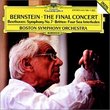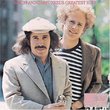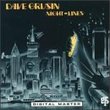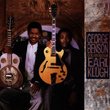| All Artists: Beethoven, Toscanini, NBC Title: Symphony 5 Members Wishing: 0 Total Copies: 1 Label: RCA Release Date: 10/25/1990 Genre: Classical Styles: Historical Periods, Classical (c.1770-1830), Symphonies Number of Discs: 1 SwapaCD Credits: 1 UPC: 078635719727 |
Search - Beethoven, Toscanini, NBC :: Symphony 5
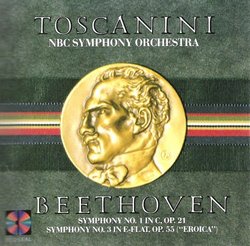 | Beethoven, Toscanini, NBC Symphony 5 Genre: Classical
![header=[] body=[This CD is available to be requested as disc only.]](/images/attributes/disc.png?v=15401716) ![header=[] body=[This CD is available to be requested with the disc and back insert.]](/images/attributes/disc_back.png?v=15401716) ![header=[] body=[This CD is available to be requested with the disc and front insert.]](/images/attributes/disc_front.png?v=15401716) ![header=[] body=[This CD is available to be requested with the disc, front and back inserts.]](/images/attributes/disc_front_back.png?v=15401716) |
Larger Image |
CD DetailsSimilarly Requested CDs
|
CD ReviewsToo fast? Not too fast for Beethoven - just right. Discophage | France | 04/01/2009 (5 out of 5 stars) "What's that notion that Toscanini conducted Beethoven "too fast"? Too fast compared to what? Compared to an established tradition deriving from Furtwängler, yes: Toscanini's Beethoven was unquestionably much faster. But compared to Beethoven? I will adamantly and emphatically contend that NO: Toscanini conducted Beethoven just right, and that it is that "tradition" that is "too slow".
My stance is based first on an observation of what Beethoven wrote on his scores - our most direct access to his true intentions, after all. It is not just the question of his controversial metronome marks - although all the great musicians profess the utmost and most humble allegiance to the composer's score and intention, it is baffling the imagination they display in finding reasons NOT to observe these metronome marks: they were added years after the compositions, the composer was deaf, his metronome was faulty, he didn't know how to use it, and what you hear in your mind's ear (especially when you are deaf!) is not what can and should be realized in the concert hall (shouldn't it be the other way around? What you hear in your mind's ear is precisely your intention, that any respectful musician SHOULD try and realize in the concert hall?). But independent of the metronome, just take the indications of character written at the beginning of each movement: "allegro con brio" (first movement of the First and Third symphonies), "allegro molto e vivace" (third and last movement of the same), "allegro vivace" (third movement of the Third), "allegro molto" (finale of the Third). Granted, such literary indications do open up some range of, well, interpretation. How fast is an "allegro"? Nonetheless, it is always going to be somewhere in the fast gear, especially when, as here, the composer added "con brio" or "molto e vivace". How faster can you get? After all Beethoven could have added "moderato" or "ma non troppo" if he had wanted it to be not so fast. I've read reviews from esteemed critics, even fans of Toscanini, maintaining that this Eroica from 1949 was "hard-driven", "unidimentional" and "problematical" (and preferring Toscanini's 1939 recording or his 1951 live one). I haven't heard these two, but I simply do not agree with the dismissal of this 1949 recording. Those who find it hard-driven should take a cure of Scherchen (Beethoven: Symphonies 1 3 6 8 (Box Set), Beethoven: Symphonies Nos. 3 & 6) and Norrington (Beethoven: Sinfonie 3 "EROICA"), who play the first movement exactly at Beethoven's metronome mark. Toscanini feels spacious in comparison! One difference with the REAL radicals is that Toscanini does take time to relax when come the more lyrical moments, starting at 1:38. Still, it is a muscular reading, ebullient, teeming with energy. It is not just a question of tempo, although the tempo does a lot. Toscanini's accents are muscular and biting, they crack like whiplashes, and his glaring winds and brass add their own punch. He dashes through the scherzo at a tempo even faster than Beethoven's metronome (circa 128 dotted half-notes to 116), making it into some lithe dance of the elves turning, in the trio, into a bacchanal. I find it irresistible. Now, all matters of tempo and faithfulness to score set aside, I happen to think that the revolutionary, trail-blazing aspect of Beethoven is illustrated much better in such an exhilaratingly dynamic and exuberant reading, bringing out all the music's youthful brashness, its ebullience and explosiveness, than in the more stately approach of Furtwängler (Beethoven: Symphonies Nos. 1 & 3 "Eroica", Beethoven: Symphonies Nos. 1 & 3 "Eroica"), Klemperer (Beethoven: Symphonie No. 3 "Eroica"; Große Fuge, The Klemperer Legacy: Beethoven Symphony No.3 ("Eroica"); Grosse Fuge) and Walter (Bruno Walter & the Columbia Symphony Orchestra Perform Beethoven: Symphony No. 3, 'Eroica,' & the 'Coriolan' Overture (Stereo CD)). It is also much more exciting. My only regret is that Toscanini doesn't take the first movement repeat (he does in the First Symphony): constraints of the 78rmp side-breaks, no doubt. But I always feel that something is missing when the repeat isn't taken (and so did Beethoven, apparently, as he decided to keep the repeat bar after having considered doing away with it due to the movement's unusual length, and performing the Symphony a few times that way). And that repeat is even more amiss when the movement is played like this: it is so good you don't have enough of it. That said, Toscanini far from rushes through his Eroica's funeral march, although, compared to Furtwängler, anything will seem rushed (but compared to anything, Furtwängler will sound like time at a standstill). He's no faster than Bernstein (Symphony 3 " Eroica ") or Szell (Beethoven: Symphonies Nos. 3 "Eroica" & 8), and significantly slower than Scherchen or Norrington (and Beethoven's metronome). Yet his march is remarkably powerful, violent even, with mighty and dramatic brass (the way he has them phrase the sf chords in the passage after 4:41 is hair-raising) and unlike Furtwängler he always retains the sense of a march, never turning the movement into some funeral lament. I've always read that Toscanini's sound was harsh, dry and unpleasant. Not here. These were recorded not in the (in)famous NBC 8-H studio, but in Carnegie Hall. The sound is good for its vintage, although in the 3rd you can hear the seams of the 78rmps side breaks, and some artificial reverb has been added, that is noticeable especially on the final chord of each movement. The First was recorded two years later but I hear no striking difference in sound. Interpretively, it follows the same approach as the third: brisk and dynamic, explosive, exuberant. Likewise, I find it absolutely irresistible. Toscanini by the way takes the Menuetto exactly at Beethoven's metronome: 108 half-notes/minute. It is wonderfully dynamic. But like everybody else's, his "slow" movement, with all its charm and lilt, is significantly slower than Beethoven's metronome mark, something like eighth-note = 97 to the composer's baffling 120. At 112 Norrington is the closest to the mark among the recordings I've heard, and of course it changes the character of the music entirely: it isn't a "slow" movement anymore, making sense of the "andante cantabile CON MOTO" character indication written by Beethoven here). At past 80 years of age, Toscanini was younger than many young conductors. And some 60 years later, he still is. " |

 Track Listings (8) - Disc #1
Track Listings (8) - Disc #1
